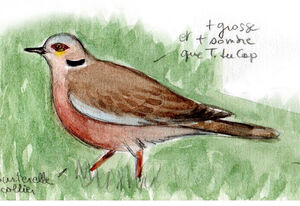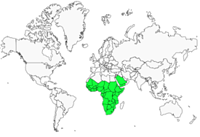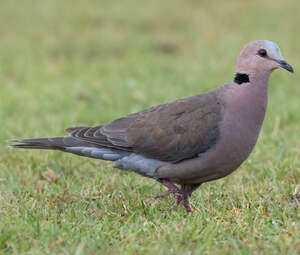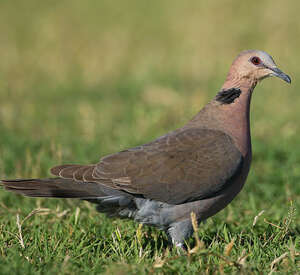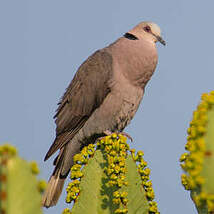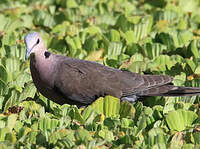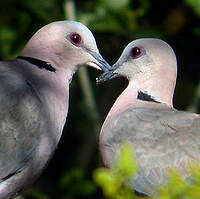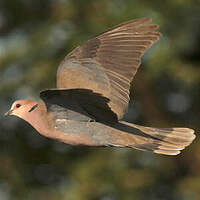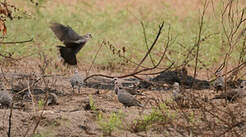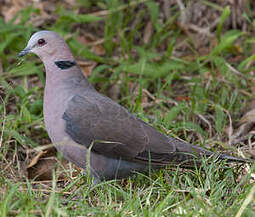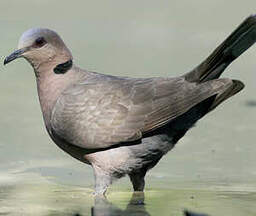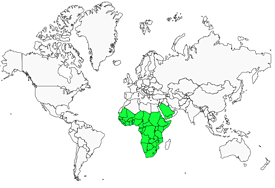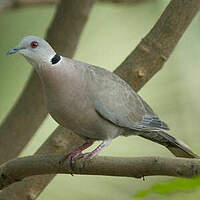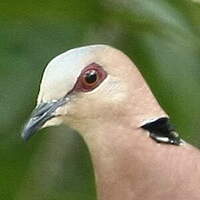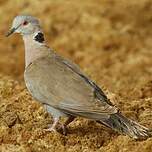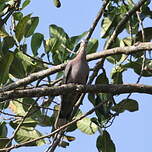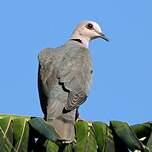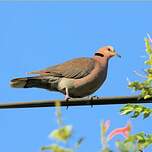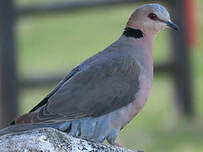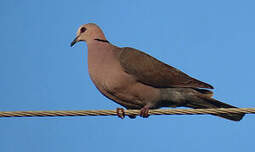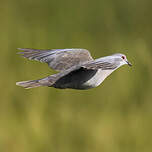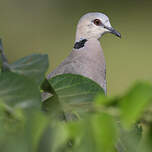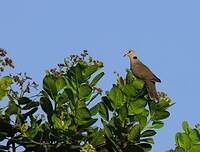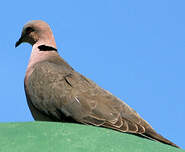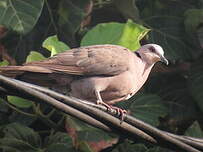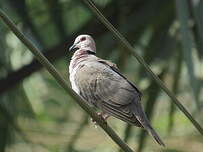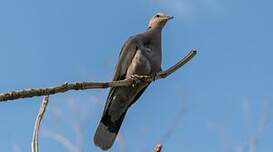Red-eyed Dove
Streptopelia semitorquata - Tourterelle à collier
Identification
The Red-eyed Dove is the largest species of the Streptopelia genus in Africa. It is larger than the Cape Turtle Dove with which it can be confused. In the adult, the head is tinged with pink, the forehead and front of the crown being light grey, this colour may extend to the entire head in the nuptial adult. The bill is uniformly black. The dark red-orange iris eye is surrounded by an almond-shaped area of skin with a deep pink hue. The neck, chest and upper belly are of a vine-pink colour. A wide half-collar of black feathers with a variable width white border is visible around the nape. The top of the body and wings is a fairly dark brown-beige, locally shaded with grey. The remiges and tail are brown, the latter barred with dark brown two-thirds of the way down. From below, the tail appears distinctly bi-coloured, blackish at the base and whitish at the tip. The legs are pink, sometimes almost coral in colour. The juvenile is similar to the adult, but more muted in colour, with the bare parts not yet coloured. The half-collar is visible only faintly. The upper feathers are fringed with beige or reddish.
Subspecific information monotypic species
Foreign names
- Tourterelle à collier,
- Tórtola ojirroja,
- rola-de-olho-vermelho,
- Halbmondtaube,
- pirosszemű gerle,
- Roodoogtortel,
- Tortora occhirossi,
- rödögd duva,
- Rødøyedue,
- hrdlička červenooká,
- hrdlička červenooká,
- Rødøjet Skoggerdue,
- savanniturturikyyhky,
- Grootringduif,
- tórtora de Rüppell,
- synogarlica czerwonooka,
- sarkanacu ūbele,
- Красноглазая горлица,
- アカメジュズカケバト,
- 红眼斑鸠,
- 紅眼斑鳩,
Voice song and cries
Habitat
The Red-eyed Dove occupies a wide range of habitats, though in smaller numbers in arid and very humid mountainous areas. It prefers wooded and semi-wooded areas where shrubs are present and dense in foliage, semi-arid and humid areas, and proximity to water (lakes, reservoirs and rivers). In South Africa, it has adapted very well to parks and gardens in urban areas.
Behaviour character trait
Outside of the breeding season, the Red-eyed Dove is usually gregarious, like other members of its genus, for the purposes of protection against predators. They gather around watering points in the early morning and evening, with the rest of the day being dedicated to foraging and resting. It is often found on the ground, especially when looking for food, or perched in trees.
Flight
Dietfeeding habits
The Red-eyed Dove searches for its food on the ground, but also in trees and shrubs. It consumes various seeds such as sorghum, millet, heliantheums, etc. but also berries such as those of the golden baskets, the Andrèze Woods and the mulberries. Vegetable elements such as rhizomes or insects such as termites sometimes make up its meal. It knows how to find food in both natural and agricultural areas.
Reproduction nesting
The Red-eyed Dove is monogamous. Its breeding season varies depending on the region since it is closely linked to climatic conditions.
In South Africa, it is thought that breeding takes place all year round with a peak in the winter and summer rainy seasons. The territorial male regularly performs ascending flights with forceful wing beats, then descends with wings and tail spread out. The courting ritual takes place on the ground or on a low, horizontal branch. In presence of the female, the male does half circles with his head lowered and neck feathers puffed out to show off his half-collar and the light grey of his forehead. After mating, the pair spends much time grooming their feathers. The nest built in a treer or bush is a flat and basic structure made of twigs and rootlets, and shielded from the view of predators by the dense foliage of the trees. It is the male who collects the building materials while the female does the assembly. The chosen location is often near water. The female lays 2 white eggs which are incubated by both adults for 14 to 17 days. The young are fed in the nest for the same period. Three weeks later, they are independent.Geographic range
Threats - protection
Sources of information
- IOC World Bird List (v14.1), Gill, F and D Donsker (Eds). 2024-04-18.
- Pigeons and Doves, David Gibbs, Eustace Barnes and John Cox
- Birds of Southern Africa, Tony Roocroft
- BirdLife International, BirdLife International
Other sources of interest
 Specification sheet created on
23/07/2023 by Nathalie Santa Maria
Specification sheet created on
23/07/2023 by Nathalie Santa MariaTranslation by AI Oiseaux.net
published: 13-10-2016 - Updated: 19-10-2016
© 1996-2024 Oiseaux.net
- Accipitriformes
- Aegotheliformes
- Anseriformes
- Apodiformes
- Apterygiformes
- Bucerotiformes
- Caprimulgiformes
- Cariamiformes
- Casuariiformes
- Charadriiformes
- Ciconiiformes
- Coliiformes
- Columbiformes
- Coraciiformes
- Cuculiformes
- Eurypygiformes
- Falconiformes
- Galliformes
- Gaviiformes
- Gruiformes
- Leptosomiformes
- Mesitornithiformes
- Musophagiformes
- Nyctibiiformes
- Opisthocomiformes
- Otidiformes
- Passeriformes
- Pelecaniformes
- Phaethontiformes
- Phoenicopteriformes
- Piciformes
- Podargiformes
- Podicipediformes
- Procellariiformes
- Psittaciformes
- Pterocliformes
- Rheiformes
- Sphenisciformes
- Steatornithiformes
- Strigiformes
- Struthioniformes
- Suliformes
- Tinamiformes
- Trogoniformes

